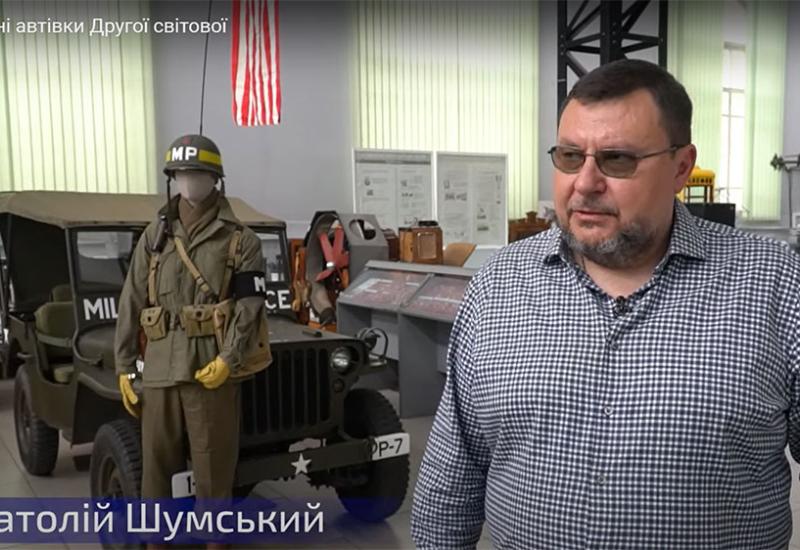In early May, the State Polytechnic Museum named after Borys Paton at Igor Sikorsky Kyiv Polytechnic Institute opened an exhibition of American military vehicles, which was supplemented by mini dioramas and models of aircraft that took part in the most important military operations of the anti-Hitler coalition in 1944.
The exhibition is dedicated to the Day of Remembrance and Victory over Nazism in the Second World War of 1939-1945. For visitors to fully understand what the exhibits tell, it is necessary to recall little-known facts from history that were hardly mentioned in the Soviet version of the history of the Second World War. Vitalii Tatarchuk, Head of the KPI Museum's Research Department of History, helped the Kyiv Polytechnic correspondent with this.
So, here is a brief background information about these military operations. Operation Overlord began on 6 June 1944 and marked a new stage in the military operations of the Anti-Hitler Coalition against Nazi Germany and its satellites on the Second Front of the European Theatre of Operations. The largest amphibious landing in world history took place then - American, British and Canadian troops landed in Normandy, France. The operation was successful, and it became clear that the defeat of Germany was only a matter of time. ‘Frank’ is the code name for a joint Soviet-American military operation involving the shuttle movement of American bombers from airfields in the UK, Southern Italy and the USSR (Poltava, Myrhorod, Pyriatyn) to launch air bombing strikes against important enemy military and industrial targets. The operation lasted from 2 June to 9 September 1944. A total of 2,207 sorties were carried out, including 18 shuttle bombings of 12 important enemy targets. The operation involved the US Eastern Air Command (8th and 15th Air Armies - a total of 10 bomber groups, and the 12th Air Force - 7 fighter groups - 1697 American pilots and soldiers); on the Soviet side, units of the Red Army Air Force: 2 fighter aviation divisions (7 fighter regiments).
During the operation, 1,030 American aircraft were serviced and trained. During 18 raids, 1955 tonnes of bombs were dropped on enemy targets. 12 important targets in the enemy's deep rear were hit. At least 100 German aircraft were destroyed in air battles and over 60 on the ground. Reconnaissance aircraft flew 117 combat missions and photographed 174 targets.
‘The exhibition opens the veil of a forgotten page of history,’ says Vitaliy Tatarchuk, ’and allows you to see with your own eyes unique military vehicles of the Second World War - 6 in total. Among them, in particular, is the Dodge WC54, the main military ambulance of the US Army at that time. It was designed to transport the wounded from the battlefield. Visitors can also see infantry vehicles, the Willys MB light command and reconnaissance vehicle, the Dodge WC51 off-road army vehicle, and others. The museum received these vehicles, which were used in two operations of the anti-Hitler coalition, for temporary display by agreement with Anatoliy Shumsky, President of the Ukrainian Military History Museum, a Ukrainian public association. In addition to the vehicles, the exhibition also included a display of historical and technical miniatures by Vadym Datsiuk, head of the Model School Local History Museum ‘History of Vysoka Pich Village’ (Vysoka Pich, Zhytomyr region). The collection includes models of aircraft, anti-aircraft artillery, maintenance equipment, miniature figures of crew members and airfield personnel - 13 in total, as well as laminated information sheets and photographs. Among the models on display is a model of a Boeing B-17 Flying Fortress bomber, the main striking force of Operation Frank. Also on display is a model of the North American P-51 Mustang fighter, which is considered the best fighter aircraft of the US Air Force during World War II. It was used as an escort for bombers in raids on Germany, helping to ensure Allied air superiority from the beginning of 1944. The museum also offers a video presentation about Operation Frank and its reflection in the exposition of the local history museum of the village of Vysoka Pich (Zhytomyr region).
At the end of our tour, Vitaliy Tatarchuk noted that today, when the world is facing a new evil - the Russian aggression - Ukraine is again at the forefront of the fight, this time against the Russian occupiers. And the example of Operation Frank shows that only through joint efforts with our allies can we defeat this new evil - Russian fascism. We, the Ukrainians, are grateful to the world for its help, and with this exhibition we are in a way reminding ourselves of the events of 80 years ago.
Medevacs, infantry vehicles, military Fords, and a rare GAZ-61 were the vehicles used in two extremely important and little-known special operations of the anti-Hitler coalition, "Frank" and "Overlord."
This unique military equipment was brought to the State Polytechnic Museum of Igor Sikorsky Kyiv Polytechnic Institute by Anatoliy Shumsky, president of the Ukrainian Military History Museum and a true fan of vintage cars and weapons. Collecting such cars is not just a hobby for Mr. Anatoliy, but a matter of life - to preserve and popularize Ukrainian heritage.

